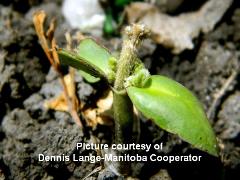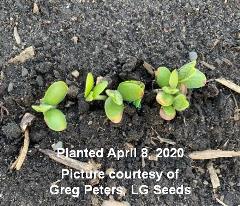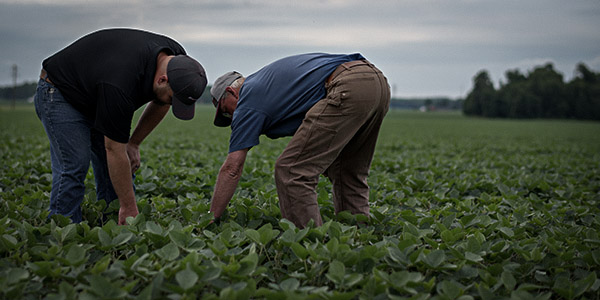AGRONOMICSUPPORT
YOU CAN TAKETO THE FIELD
Understanding Soybean Frost Injury
Temperature maps recently showed areas of the Midwest with overnight temperatures reaching as low as 25 degrees, and it appears that temperatures will be cool again overnight on May 8. Excellent soil conditions promoted earlier than normal planting of soybeans, but these early planting dates have a higher potential for frost injury. Despite early planting dates, we have dealt with freeze issues as late as June, which is well past the average last frost date of the end of April for much of the Corn Belt, and mid to late May in the northern areas.
Air temperatures must reach lows of 28 to 30 degrees for several hours to kill soybean tissue, but many factors impact the extent of the damage. Once the trifoliate develops, frost injury will occur at temperatures of 32 degrees or lower. We have seen injury when temperatures are 36 degrees or lower around field edges, waterways, terraces or any areas that have high vegetative growth from a radiant freeze. This happens on cold, clear nights where the plants lose more heat than they receive - creating a temperature inversion where cold air is trapped by warmer air above it.
 The greatest concern is that all growing points of the soybean plant are above the soil and they are exposed after the cotyledons open. Newly emerged soybean plants that are in the VC stage have a higher tolerance to cold due to the heat that is given off by the soil. Cotyledons also have a higher tolerance because they have a heavier wax layer on the surface. Research has shown cotyledons are full of solutes and sucrose that act as buffers to freezing temperatures protecting the two growing points at the base of the cotyledons. A study at North Dakota State University showed that temperatures as low as 24 degrees were required to kill half the seedlings. Soybean plants in the crook stage are more susceptible because the hypocotyl is sensitive to freezing. If the hypocotyl is frozen, all growing points above it will die.
The greatest concern is that all growing points of the soybean plant are above the soil and they are exposed after the cotyledons open. Newly emerged soybean plants that are in the VC stage have a higher tolerance to cold due to the heat that is given off by the soil. Cotyledons also have a higher tolerance because they have a heavier wax layer on the surface. Research has shown cotyledons are full of solutes and sucrose that act as buffers to freezing temperatures protecting the two growing points at the base of the cotyledons. A study at North Dakota State University showed that temperatures as low as 24 degrees were required to kill half the seedlings. Soybean plants in the crook stage are more susceptible because the hypocotyl is sensitive to freezing. If the hypocotyl is frozen, all growing points above it will die.
 Soil temperature is mentioned as a factor that helps protect young soybean plants as they emerge. Most soil temperatures have been in the mid to upper 50’s and these temperatures will generally be slow to cool especially in areas that have ample soil moisture. Portions of the Midwest have been abnormally dry, and this can lead to an increased risk of frost damage. Soil moisture can have a cooling effect on soil temperatures, but it also brings stability as we have rapid changes in atmospheric temperatures. The other concern is that dry soils have increased pore spaces that will allow low temperatures to penetrate deeper into the soil profile. High soil residue can help bring more stability to soil temperature because it helps insulate the soil from heat being lost. Low lying areas can be susceptible because cold air settles in these areas.
Soil temperature is mentioned as a factor that helps protect young soybean plants as they emerge. Most soil temperatures have been in the mid to upper 50’s and these temperatures will generally be slow to cool especially in areas that have ample soil moisture. Portions of the Midwest have been abnormally dry, and this can lead to an increased risk of frost damage. Soil moisture can have a cooling effect on soil temperatures, but it also brings stability as we have rapid changes in atmospheric temperatures. The other concern is that dry soils have increased pore spaces that will allow low temperatures to penetrate deeper into the soil profile. High soil residue can help bring more stability to soil temperature because it helps insulate the soil from heat being lost. Low lying areas can be susceptible because cold air settles in these areas.
 Frost injury to the soybean plants appears as water-soaked lesions on the hypocotyl, cotyledons, and leaves. Scout fields three to five days after potential frost injury occurred and look for firm, healthy stems, cotyledons, and regrowth at the growing points. Plant stands may be reduced but the benefit of a soybean is that they can compensate for partial stand losses.
Frost injury to the soybean plants appears as water-soaked lesions on the hypocotyl, cotyledons, and leaves. Scout fields three to five days after potential frost injury occurred and look for firm, healthy stems, cotyledons, and regrowth at the growing points. Plant stands may be reduced but the benefit of a soybean is that they can compensate for partial stand losses.
Download a copy of this technical bulletin here: Frost Injury to Soybeans
Sources and Additional Information:






Technical Team Agronomist